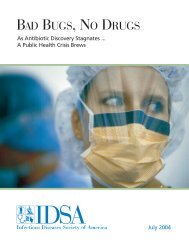Community-Based Surveillance of Antimicrobial Use and ...
Community-Based Surveillance of Antimicrobial Use and ...
Community-Based Surveillance of Antimicrobial Use and ...
- No tags were found...
Create successful ePaper yourself
Turn your PDF publications into a flip-book with our unique Google optimized e-Paper software.
<strong>Community</strong>-based surveillance <strong>of</strong> antimicrobial use<strong>and</strong> resistance in resource-constrained settingsrefined. The clusters <strong>and</strong> the numbers per cluster need to reflect the health‐seekingbehaviour <strong>of</strong> the population in the area. For example, if 80% <strong>of</strong> the population seekshealth care in the public sector, 80% <strong>of</strong> the facilities need also to be in the public sector.However, establishing who uses what kind <strong>of</strong> facility in which sector is very complex<strong>and</strong> may be impossible to do in many resource‐poor settings. For example, while it maybe true that more than 80% <strong>of</strong> the South African population is uninsured, they may alsoresort to out‐<strong>of</strong>‐pocket purchase <strong>of</strong> health services <strong>and</strong> medicines, while being nominally“public sector dependent”. In India, the majority <strong>of</strong> people access health care in theprivate sector, despite the presence <strong>of</strong> public sector facilities.• Including multiple private <strong>and</strong> public sector facility types can improve the validity <strong>of</strong>any inferences that may be drawn. Selecting appropriate facilities in developing countriescan be difficult for several reasons, including the non‐availability <strong>of</strong> accurate listings <strong>of</strong>facilities, lack <strong>of</strong> information <strong>and</strong> variability in the catchment population <strong>of</strong> facilities,overlap in the areas <strong>of</strong> service by facilities, <strong>and</strong> a lack <strong>of</strong> cooperation from r<strong>and</strong>omlyselected facilities.• The number <strong>of</strong> prescriptions to be examined per month was decided upon based on thevariations expected. The minimum number <strong>of</strong> 30 antibiotic‐containing prescriptions perfacility per unit <strong>of</strong> time should be acceptable for cross‐sectional surveys, but a moreprecise sample number could be derived for time series analyses using the datagenerated in this study.8.3.2.2 Data collection• Data were collected by qualified pharmacists or specially trained individuals at mostsites. However, the data quality varied, especially in relation to the more detailed datarequired for calculating the number <strong>of</strong> DDDs per 100 patients. Where data on doses <strong>and</strong>durations are not consistently recorded, such calculations will not be possible. These datawere more prone to error <strong>and</strong> showed much wider fluctuations than the data based onthe percentage <strong>of</strong> ABM‐containing prescriptions. Analysing data on additional ABM use,where patients had received more than one ABM, was difficult using the data setsprovided. Attention to training <strong>and</strong> supervision <strong>of</strong> data collectors is essential.• The required sample sizes, according to the agreed protocols, were <strong>of</strong>ten not obtained inmost sites. There were wide variations in the numbers <strong>of</strong> prescriptions noted betweenmonths <strong>and</strong> facility types in some sites. The reasons for these variations were myriad, butsuch variations could be minimized by continuous monitoring.• Monthly data did not show much variation. However, collecting data every month in asystematic manner is probably more sustainable than data collection at intervals <strong>of</strong> 3 to 6months.• Planning interventions is made easier if data are collected on the indications for ABMuse. Such data are, however, difficult to analyse because <strong>of</strong> the number <strong>of</strong> variables. Ifcommon out‐patient illnesses can be grouped (e.g., based on systems, symptoms), datauseful for developing interventions can be generated. One site attempted to determinethe degree <strong>of</strong> compliance with St<strong>and</strong>ard Treatment Guidelines, <strong>and</strong> thus with theEssential Drugs List (EDL).92




